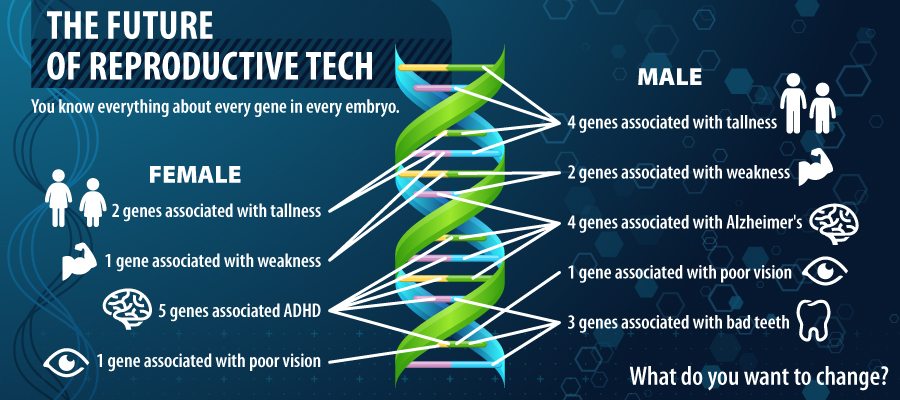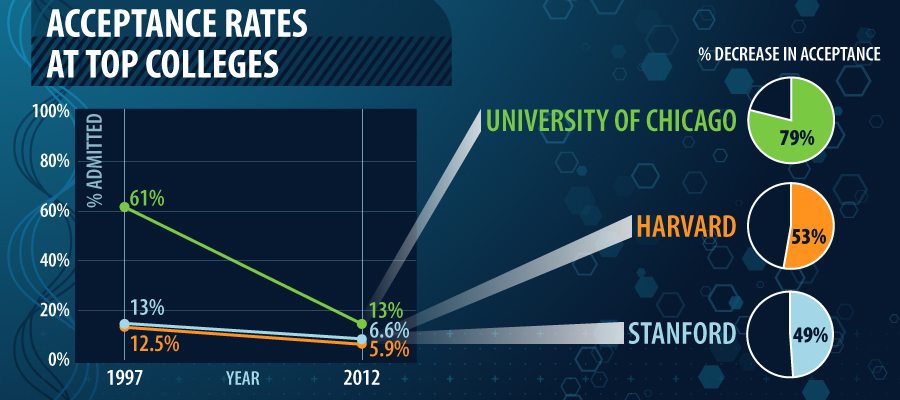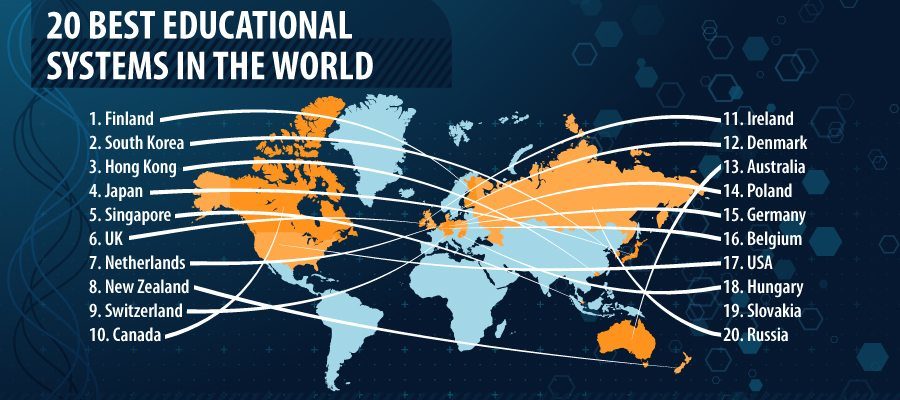Gone are the days of exploring empty lots, climbing trees, or playing in a stream. You’ve got band at four, volunteering at five, and your tutor at a quarter til six; then you’ve got 4 hours of homework. Welcome to being a kid in the 21st century. Increasingly, every moment of our children’s lives are planned out, from before they are born, all the way through graduate school and first internships or jobs. While the economy might be bad, the workplace competitive — and we certainly do want a well-trained and tech-savvy generation — what price are we willing to pay?
Designer Babies
Tracing the trend of a pre-planned childhood starts, well, before childhood. We’re still in the early stages of full-fledged “designer babies”, but a variety of services do offer the chance to look at and potentially alter characteristics of your unborn child. The FDA met last February to discuss the possibility of using the DNA of three “parents” in in vitro fertilization. Potential therapies would prevent illnesses like muscular dystrophy and respiratory problems in unborn children. While this type of procedure errs on the side of gene therapy, and not the science fiction style “engineering” of babies, there are some decidedly more far flung procedures being developed.
23andMe, a Mountain View-based business named for your 23 pairs of chromosomes, focuses on analyzing DNA to provide health and ancestry data. The service has been increasingly utilized by adoptees. Though the company notes that they do not plan to develop technologies through which parents could choose the exact characteristics of their children, a patent filed 5 years ago for pre-implantation genetic diagnosis (PGD) was made with the thought that the technology could be applied in fertility clinics to help with the donor selection process. While PGD was initially presented as a way to prevent predispositions for diseases in children, using PGD for gender selection of babies is now a multimillion dollar industry. $18,000 is the list price for changing your baby’s gender in a high profile clinic, a choice made by some 4,000-6,000 couples yearly.
[Tweet “$18,000 is the list price for changing your baby’s gender in a high profile clinic”]
True designer babies, in which parents can select a child’s abilities, intelligence, and looks, is still a distant proposal. At this point, PGD and other screening methods are largely used for medical purposes. What the growth in techniques for peeking at an unborn child’s genetic make-up does hint at–as noted by Sigrid Sterckx of the Bioethics Institute Ghent in Belgium– is “a different attitude, not just about disease-related traits, but non-disease traits.” As noted by a Live Science article, test-tube babies were viewed as an abomination 30 years ago, yet today are very accepted and commonplace.

A Nature report from 2008 details the following predictions for the next 30 years of reproductive medicine:
- Sperm and eggs will be successfully derived from induced pruripotent stem (iPS), the stem cells that can potentially develop into any cell type. Theoretically, this means that anyone could give birth, from newborns to 100-year olds.
- Embryos grown through the previously detailed method could be used for research. Because they could be grown in peatree dishes, experimenting on them wouldn’t be seen as morally repugnant.
- Artificial placentas will enable the creation of as many or as few children as you want. Think, “a fetus floating freely in a fluid and the umbilical cord attached to a machine.”
- Tha banking of cells from people when they are very young. These cells can be reintroduced at a later point to correct genetic orders when older.
- A woman’s period of fertility will be extensible indefinitely by producing germ sells from iPS technology.
- ‘Genetic cassettes’ could be inserted at the embryonic stage to correct particular diseases.
- Access to in vitro fertilization will expand, particularly for women in developing countries. Removing all the expensive components, IVF will be available for less than $100 USD.
With our current obsession with assuring our children’s success and safety, do you really trust people to just let future children be themselves?
The Pressures of Childhood
While our true capacity to alter children before they’re even born is years in the future, the last several decades have pushed our already born children mercilessly. Think back to your own childhood. Depending on your age, I doubt you were pushed to get into a prestigious kindergarten so you can get into college (it’s actually called “kindergarten wars”), land internships in high school, or take a full load of AP classes. Today’s students aren’t allowed to actually be children for fear of falling behind a pre-planned path to success.

Blame it on increasingly competitive college admissions, the job market, or wanting your child to live up to their potential. However you put it, hyper-pressurizing, and over planning our children’s lives is taking its toll. For younger children, the irony of too much structured achievement is that it’s actually detrimental past a certain point. Yes, language acquisition, music lessons, and sports are good for your child’s development, but so is unstructured play. Unstructured play has been shown to help students develop executive function, one of the largest predictors of school success. Peter Gray, author of Free to Learn: Why Unleashing the Instinct to Play Will Make Our Children Happier, More Self-Reliant, and Better Students, summarizes the importance of free play with the following quote: “In free play, children learn to make their own decisions, solve their own problems, create and abide by rules, and get along with others as equals rather than as obedient or rebellious subordinates.” Executive function is a broad term, but includes cognitive skills such as long-term planning, self-regulation, task initiation, the ability to switch between activities, and organization. In short, skills you need to be successful.
For high schoolers, incessant pressure is arguably worse. While they might have been set to manage higher levels of stress as they get older a few decades ago, now we have a generation of students who have been hyper pressurized for their whole primary school experience. Panic attacks and generalized anxiety disorders are on the rise for American teenagers, and, according to a poll conducted by NPR, 40% of parents say their high schooler is extremely stressed. You might have known the stress of a big zit, going to prom, or being bullied; today, the stress is primarily academic. In the word’s of several students from the same study:
- “Academic stress has been a part of my life ever since I can remember,” wrote Bretta McCall, 16, of Seattle. “This year I spend about 12 hours a day on schoolwork. I’m home right now because I was feeling so sick from stress I couldn’t be at school. So as you can tell, it’s a big part of my life!”
- “At the time of writing this, my weekend assignments include two papers, a PowerPoint to go with a 10-minute presentation, studying for a test and two quizzes, and an entire chapter (approximately 40 pages) of notes in a college textbook,” wrote Connor West of New Jersey.
[Tweet “40% of parents say their high schooler is extremely stressed.”]
There are numerous stories online, with descriptions of elementary students vomiting and hiding in the bathrooms to avoid high stakes tests. The Orange County Register has detailed the pressures on high achieving high schoolers for some time now, including straight A students driven to cheating for fear of not getting into Stanford, and even students suspected of attempting to hack school computers to gain access to test materials and change grades. A senior, student body association president at a local high school notes that “We are at a point in society where a good GPA and courses aren’t an addition to a resume, they are an expectation.” Accompanied with multiple AP courses a semester, volunteer work, enrolling in clubs, taking college classes in the summer, and receiving tutoring, the burden is just too much.
Alternatives
Some of the ultimate aims dictating educational policy in recent years involve preparing a highly skilled and tech savvy workforce. On a family level, the extreme push in education is often made for the right reasons: college admissions are competitive, the workplace is competitive, and kids need something to make them stand out. The only problem is that our push to remain competitive hasn’t worked. In general, nations that allow children to play, and explore content on their own outperform the US by a number of education metrics. While the US and UK are requiring more hours in school, and with schoolwork at home, many of the top ranking east Asian nations are limiting students’ time at school, to ease detrimental levels of stress.

Finland had the highest ranked educational system in the world in 2013. Contrary to the long scripted lessons provided by Common Core Curriculum in many US states, Finland allows 15 minutes of unstructured time for play for every 45 minutes of instruction. While the US continues to push early intervention and instruction, more homework for younger children, lack of breaks, and high stakes testing for young students, here are some crucial points on Finland’s education system. As noted by MBC Times:
- No school before 7 years old.
- No homework for younger children.
- No exams for students under 13.
- All classes have students of mixed ability.
- Never more than 16 students in science classes.
- Tons of breaks every day.
- Teachers must have masters level degrees.
- Teacher training is paid for by the government.
Besides free play for younger children, studies have conclusively shown that other activities traditionally linked with adolescence are predictive of future success and overall development. Daydreaming has been shown to help with creative problem solving by recruiting the “executive network” of the brain. Daydreaming is a natural problem solving state, and viewed as increasingly important as one of the few states our brain enters that utilizes both our higher organizational thoughts and increases access to the memory center of the brain. Risk taking, an action hard to enact in a traditional classroom, has been established a crucial procedure in growing your child’s self-worth and esteem. Independent discovery is highly linked with both play and risk taking, and helps students to both learn new facts more thoroughly, and discover new ways to learn. While these may sound basic–and things every child does–the current climate of what makes a “successful” child doesn’t leave time.
[Tweet “Daydreaming has been shown to help with creative problem solving by recruiting the “executive network” of the brain.”]
